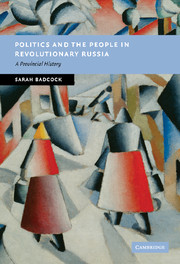Book contents
- Frontmatter
- Contents
- List of figures and table
- Notes on the text
- Acknowledgements
- Maps
- 1 Introduction
- 2 The February revolution: whose story to believe?
- 3 The Socialist Revolutionary Party and the place of party politics
- 4 Choosing local leaders
- 5 Talking to the people and shaping revolution
- 6 Soldiers and their wives
- 7 ‘Water is yours, light is yours, the land is yours, the wood is yours’
- 8 Feeding Russia
- Conclusions
- Bibliography
- Index
- NEW STUDIES IN EUROPEAN HISTORY
4 - Choosing local leaders
Published online by Cambridge University Press: 10 August 2009
- Frontmatter
- Contents
- List of figures and table
- Notes on the text
- Acknowledgements
- Maps
- 1 Introduction
- 2 The February revolution: whose story to believe?
- 3 The Socialist Revolutionary Party and the place of party politics
- 4 Choosing local leaders
- 5 Talking to the people and shaping revolution
- 6 Soldiers and their wives
- 7 ‘Water is yours, light is yours, the land is yours, the wood is yours’
- 8 Feeding Russia
- Conclusions
- Bibliography
- Index
- NEW STUDIES IN EUROPEAN HISTORY
Summary
The personalities and political persuasions of those local people who led grass-roots politics played an important part in determining the climate and policies of local politics. This chapter will concentrate on the most tangible section of local leadership, those who were elected into positions of authority and representation for the community. These elected leaders formed an important conduit between local people and the various organs of power that developed in 1917. Those individuals selected by their communities to represent them at every level, from the Constituent Assembly right down to village committees, were invested with authority that came from their direct selection and were a significant influence on the climate of local politics. Though these local leaders cannot be considered to represent all local leaders, many of whom did not participate in any electoral process, they can at least offer us a starting point. This chapter will develop our understanding of the grounds on which elected leaders were selected, who they were and the multiple pressures that they faced.
A profound dichotomy developed for local leaders in the course of 1917. They were selected, generally speaking, because they were seen to be able to reflect specifically local demands and concerns, yet their very participation in the structures of power implicitly moved them away from these local concerns and towards the agendas set at national level by political parties, the Petrograd Soviet and the Provisional Government.
- Type
- Chapter
- Information
- Politics and the People in Revolutionary RussiaA Provincial History, pp. 87 - 122Publisher: Cambridge University PressPrint publication year: 2007

